Taking on an allotment for the first time is exciting and scary. I know because I’ve just done it – I’ve had my first allotment for a year and guess what, it was fine 🙂 Yours will be too. Below are some of my tips for allotment newbies to help speed you on your way to fruit and veg success!
This article was first published in December 2016 and I now have almost a decade of additional allotment experience to share, if you’re in need of extra help, join my newsletter and community, or ask a question in the comments below.
1) Spend ages planning the layout
I excitedly drew my allotment on paper but on reflection and discussing it with more experienced allotmenteers, I changed it to the one above. Thankful I hadn’t planted anything already. It pays to spend as long as possible planning the layout, thinking about how you’ll use it practically across the year. E.g. My first plan had 7 small beds for good crop rotation. But this wasted some space and created more paths than necessary which would be a pain weaving in and out with a wheelbarrow. Instead I created three long beds and paths right the way across.
2) Wonders of weeding
In my first winter I got down on my knees and hand weeded the entire plot. It’s more enjoyable than it sounds and it’s paid off big time for two reasons. 1) using a fork to loosen soil and then a handfork to get the weeds out meant their roots were out properly so I barely had any weeds there for the rest of the year 2) I learnt to love the wonderful plants that weeds are, and I recognise them all – knowing the plants you don’t want on the allotment as much as the ones you do is important. In future you’ll know what’s a weed seedling and what’s not, you’ll also know which to worry about and which to go “meh whatever” to. (I’ve since written this book about weeds!)
3) Perennial produce
Busy busy. Our lives are busy. I don’t live near my allotment so can only visit once a week really, twice if I’m lucky. From the outset I was looking at ways to minimise workload and maximise food output. Perennial plants that don’t need to be grown from seed every year really help. E.g. super dwarf Apple trees on M27 rootstock (they have to be small to not anger neighbour allotment holders), Asparagus (they take up quite a bit of space but are expensive in shops and last for decades), Artichokes, Raspberries, Rhubarb, herbs like Rosemary etc. They still need maintenance, but you’re not repotting and digging.
4) Organic aims
While I’m not an organic gardening preacher, I do advocate striving for organic practices and using chemicals only as a very last resort. This is really just common sense because 1) chemicals are generally unnecessary and expensive – you don’t need them 2) I really want my veg and fruit to be as pure and natural as they can be when grown in a polluted mega city like London 3) I respect nature too much and don’t want to cause an imbalance in the ecosystem within my allotment (which in the long run balances out the problems itself). Personally, I don’t use chemicals when gardening at all so I’m confident my produce is organically grown. I never, ever use pesticide.
5) Get rid of old equipment and plants
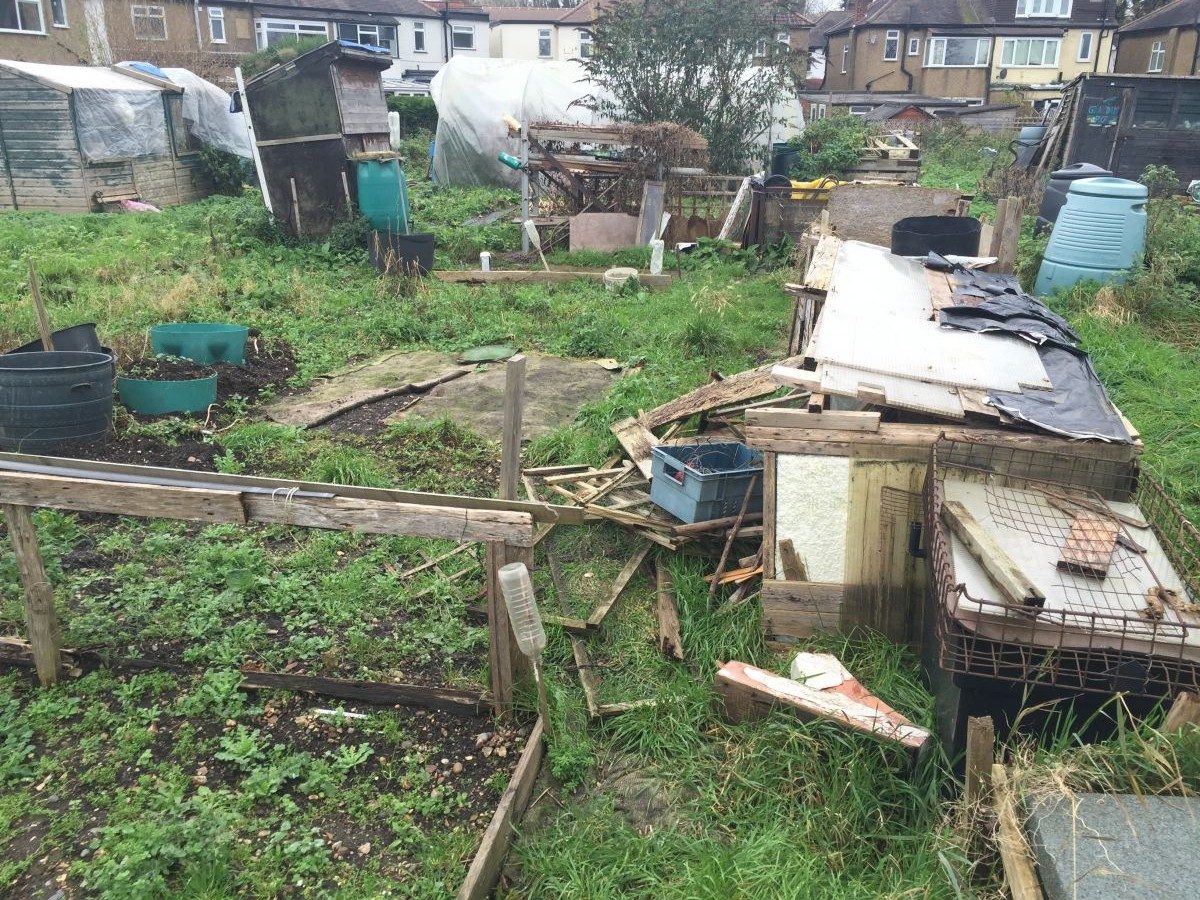
When I arrived on my plot (above) there was loads of equipment which was cool… Not. At first I thought this would all prove useful and how handy to have all of this stuff. So wrong. For one, most of it was broken, it’s also largely unnecessary (see the next point!) If your plot is full of equipment, give it a once over to check for any golden nuggets but otherwise, take it to the tip immediately. Get it out of there and release your land for a clean start! I’ve been unlucky and have 3×3 m of metal junk that couldn’t be burnt on site. I still don’t know how to get rid of it (without a car of my own). Oh yeah, get rid of the plants too. It’s better to know exactly what plants you have. So although I had rhubarb and raspberries on my plot, I’d rather know what variety they are. My advice? Get rid, start again.
6) You don’t need that much equipment
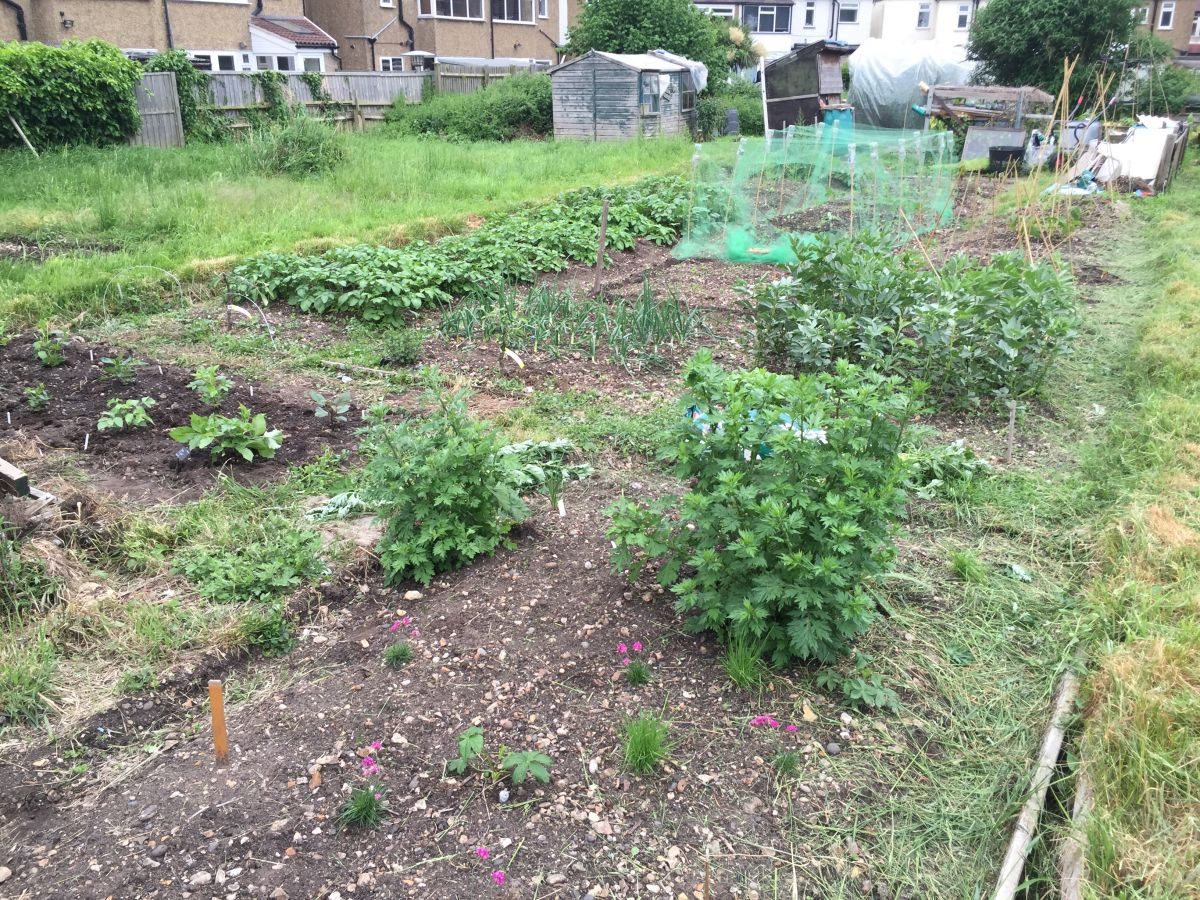
I thought I would need loads of tools and a greenhouse to grow all of my plants. In reality my allotment is now bare of all equipment except a tiny shed and I only ever really use a fork, spade, hoe, secateurs, hand trowel and hand fork. And a good pair of thin gardening gloves. You don’t need to grow your plants from seed either, plugs from a nursery make things so much easier. That said, I do grow everything from seed or cutting because I am interested in how plants grow – and I was amazed to fill an entire 125m squared allotment with the seedlings grown only in our little flat’s front window. It still amazes me now thinking about it! Gardening can be very space efficient.
7) Be selective about the plants you grow
I spend months choosing the plants I will grow in gardens and that includes my allotment. Winter is exciting because it’s about dreaming, planning and yes, shopping! Get that credit card ready people cos it’s time for some retail therapy. But don’t just go to a nursery and buy whatever is there. Be selective. Have a plan in place for the exact plants you want and only buy those. For example, look for disease resistant seed varieties and F1 cultivars which are generally strong growers due to their hybrid vigour. It’s better to have a shopping list for most of the year to buy them all in one go than to waste time and money buying a bit of this and a bit of that. Personally, I only buy from the very best nurseries and suppliers where I can be sure I know exactly what I am buying. It pays off in the end.
8) Let’s talk about quantities
Limit yourself to the number of veg and fruit types you grow. Learn from my mistake! I went crazy and bought tonnes of varieties and types of veg. This created loads of unnecessary work in caring for all the different types of plants and meant we had small quantities of each type. That was fine at the time because I was learning about lots of veg intentionally. Next year however I will limit myself to fewer types of veg and grow much higher quantities of the ones we like. We just didn’t have enough carrots for instance and I was lured into growing the trendy purple ones (which are gross). It sounds obvious now but you need far fewer plants and space for those that produce lots of veg on one plant (like French beans), and you need a great number of carrot plants and space when you only have one root per plant.
9) Harvesting
Going into my allotment I was so focussed on the sowing and growing I didn’t give enough thought to the picking, storing and cooking. I hadn’t appreciated that many vegetables and fruit have a limited 1 – 2 day window when they are perfect for eating – very difficult when I was down there only once or twice a week. In particular raspberries, courgettes, broccoli and beans. On one Saturday they wouldn’t be ready, then the following Saturday they’d gone past their best. I’ll be hotter this year on predicting the picking days.
10) Keep reading
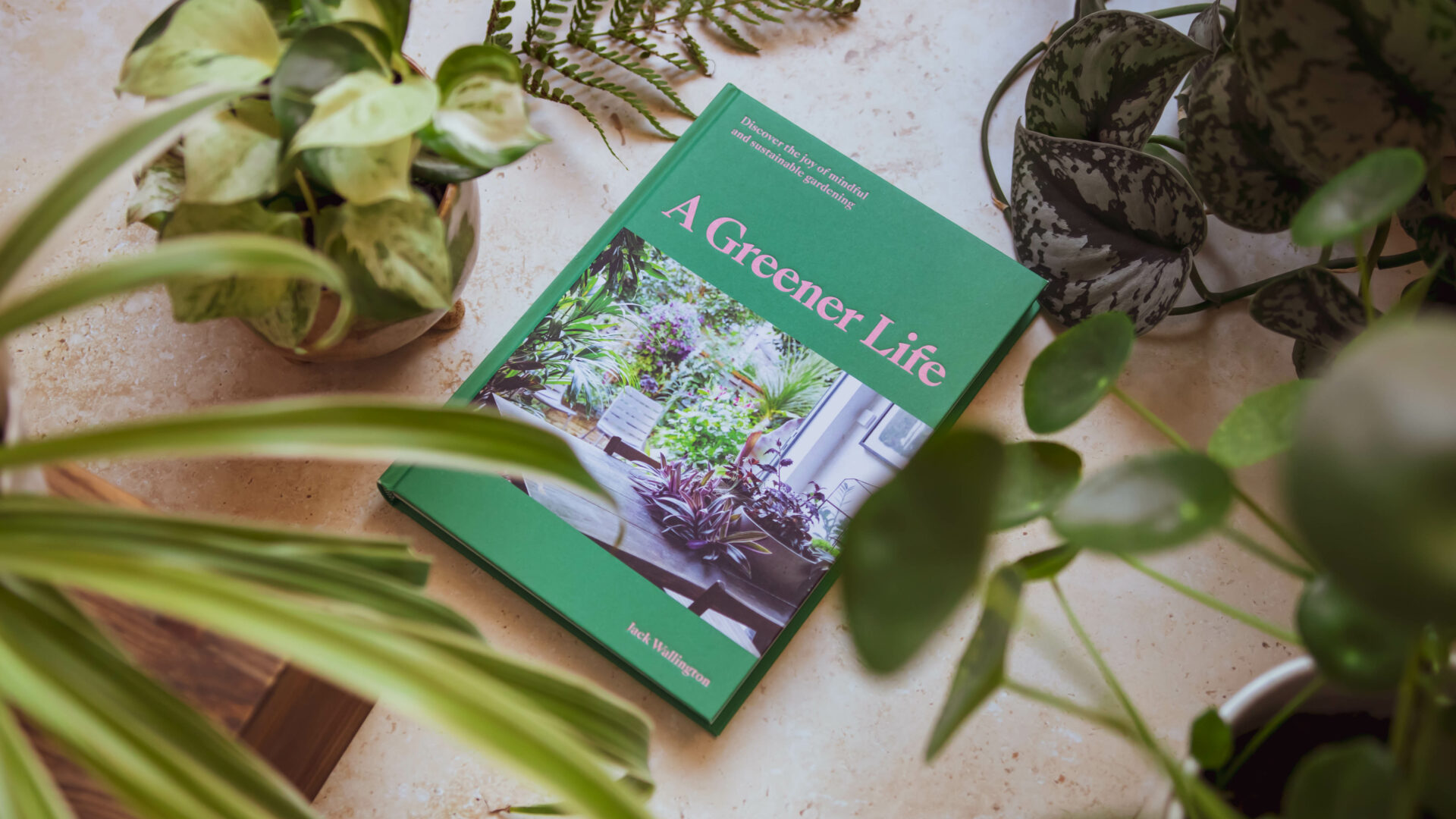
You can just get stuck into gardening without any experience (it’s the best way to learn) but reading about gardening is enjoyable and will speed you along to success much faster. We’ve only got so many seasons on this planet afterall, don’t waste one. I was studying RHS Level 2 (the GCSE equivalent horticulture course) which teaches everything you need to know about plant growth and problems. However I learnt a great deal more practical and personal experience from books, magazines, online and TV shows like Gardener’s World and Beechgrove Garden. [since writing this article I’ve now published my own book called A Greener Life which includes all of my favourite vegetables and organic growing techniques.]
11) Think about the seasons
The first thing I was taught by my friend Philippa Gould at my local community garden, Eden in Clapham, is that you can be growing something every month of the year, even in winter. Winter broadbeans, peas and garlic. Most brassicas are planted in early summer but are harvested through winter (like brussels, kale and broccoli). If you are lucky to have a greenhouse you can even keep the salad leaves going into the depths of the dark winter days.
12) At one with the earth
Know and protect your soil. The soil of your allotment is the giant battery that powers all of your plant growth. Understand what it consists of (sand, clay, silt – a mix?), how fertile it is, how freely it drains water, does it have lots of lovely air pockets and a nice uncompacted structure. I don’t dig over my allotment because I feel the worms do a good enough job of that. But, to keep things simple for fellow newbies: 1) don’t tread on soil you’re growing on as it will squash the air pockets out and block root growth 2) replenish its nutrients annually with a thick layer of peat free compost or well rotted manure 3) watch it carefully through the year to understand how it holds water 4) rotate crops every year, never growing the same (except those perennials!) crops in the same place to prevent pest and disease build up.
13) Talk to me
… and to others 🙂 Allotmenteers are a friendly bunch and only too happy to help answer questions. I’m here if you ever need me, ask a question in the community, and there are lots of other grow your own newbies muddling through to make their allotments work. No one knows everything because it’s impossible to know everything about plants in one life time. That’s the joy. Have fun and good luck!
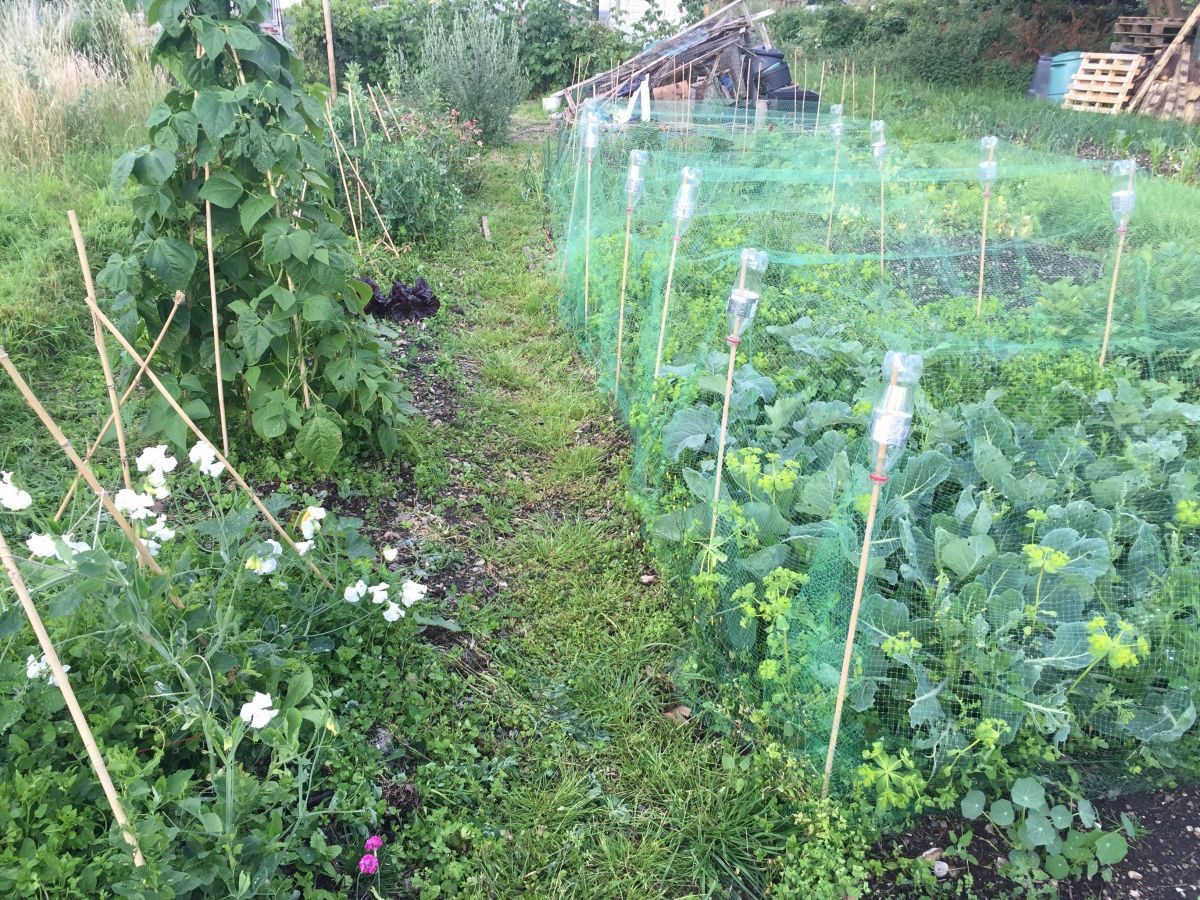
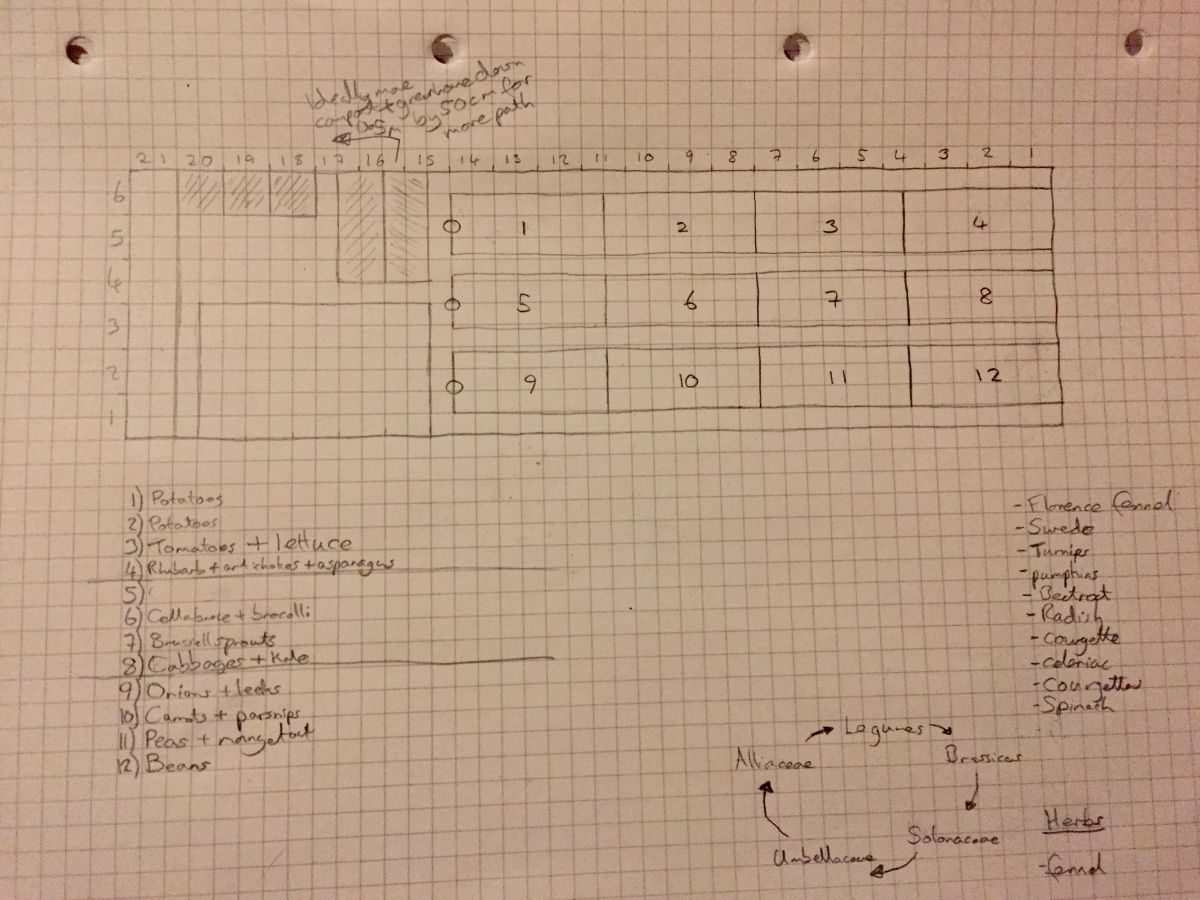
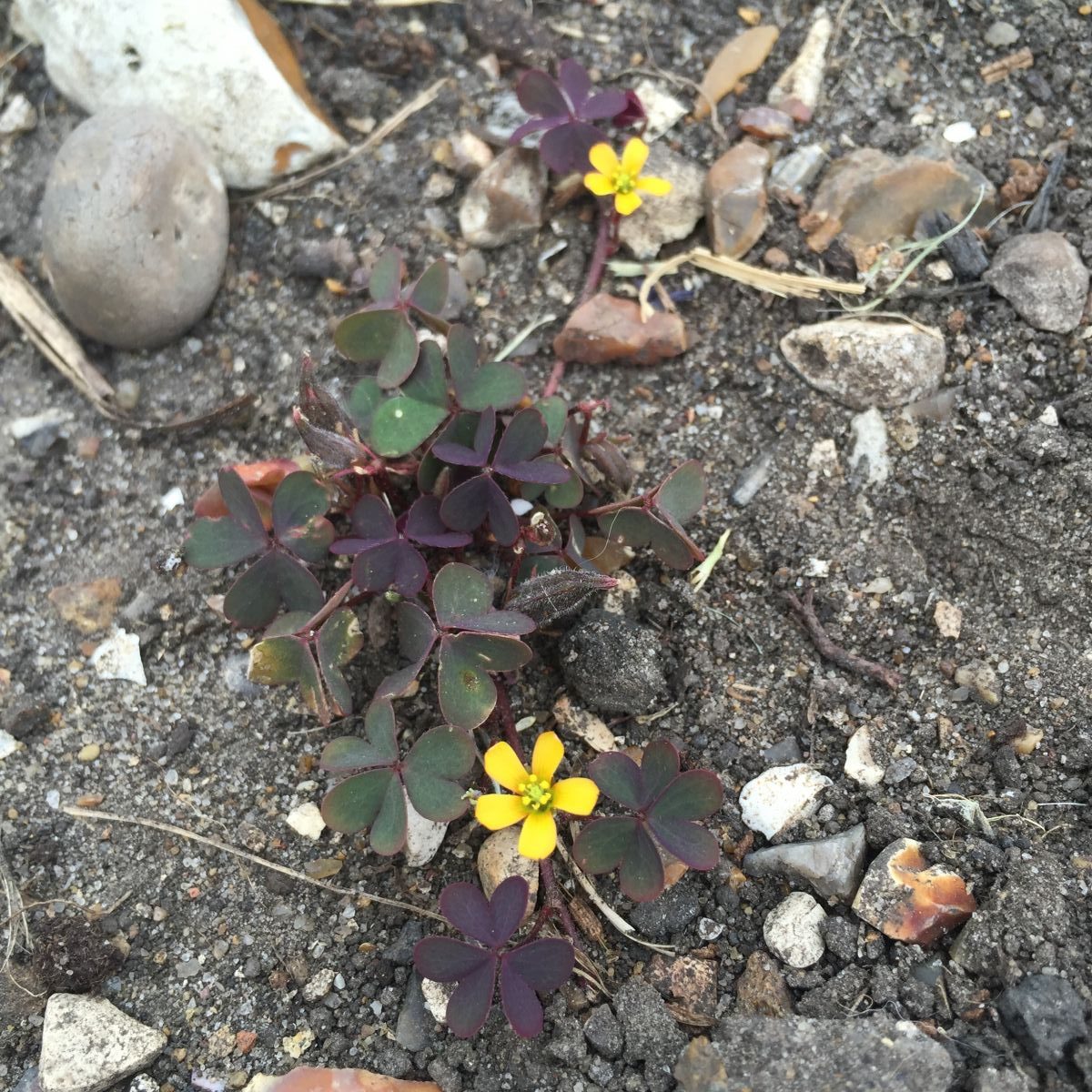
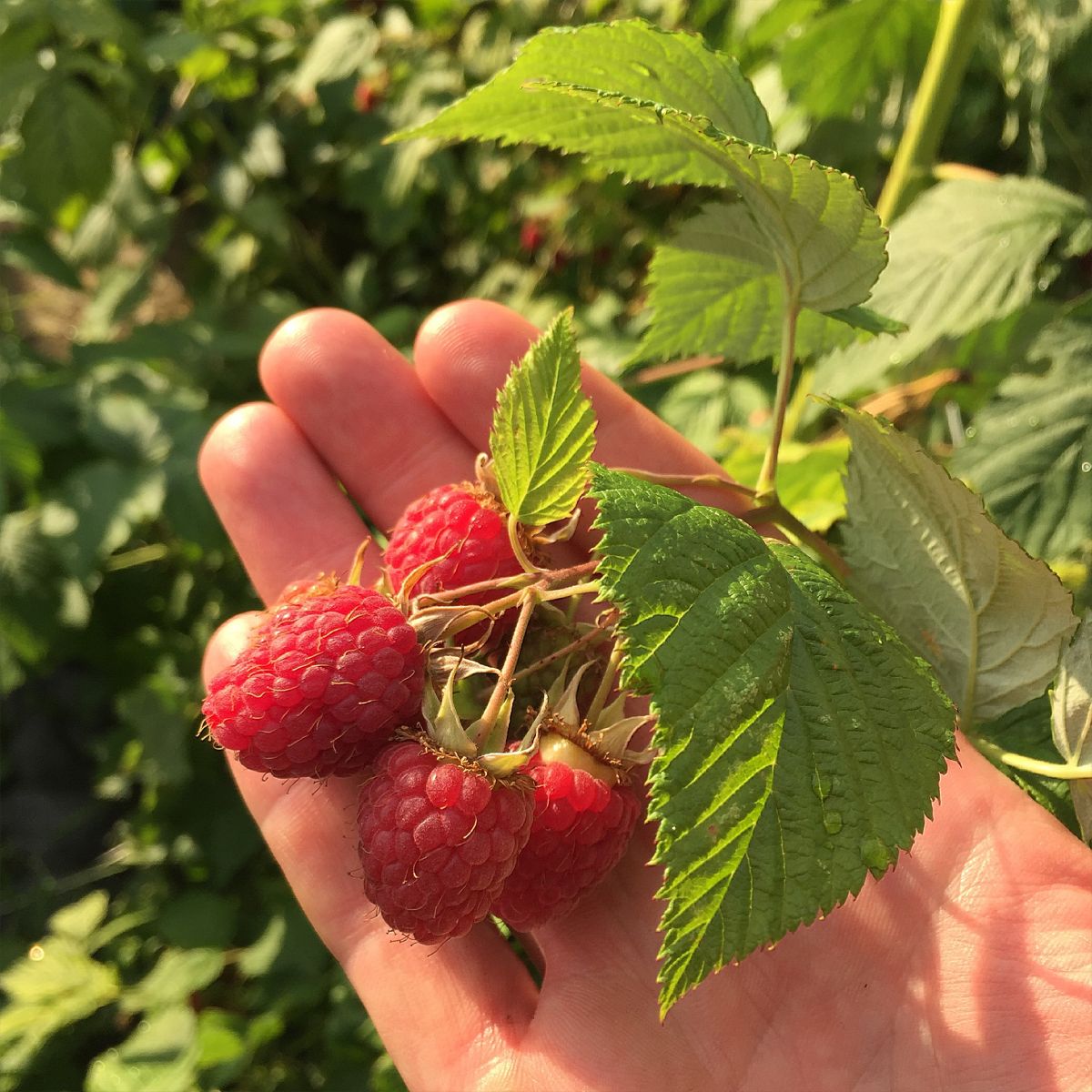

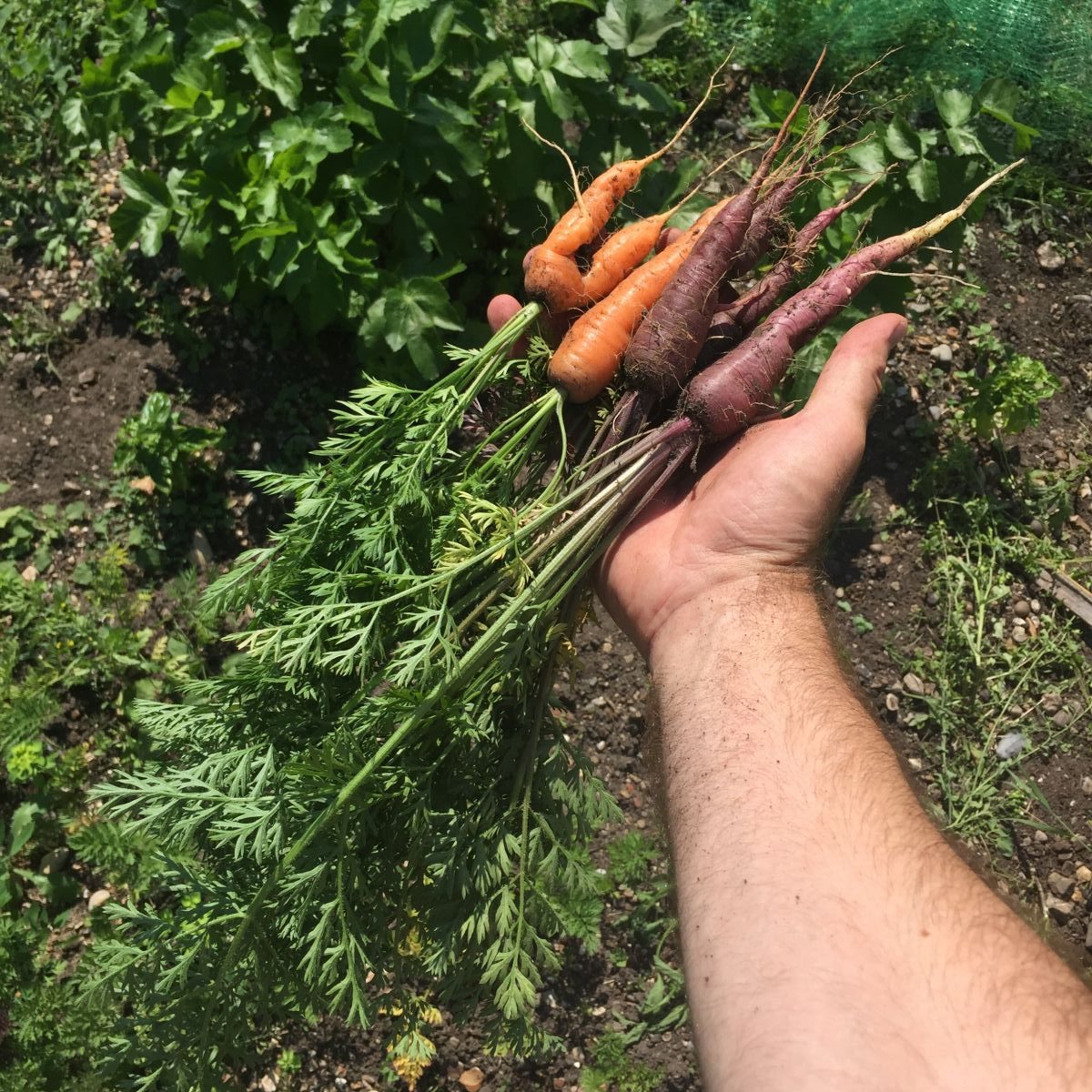
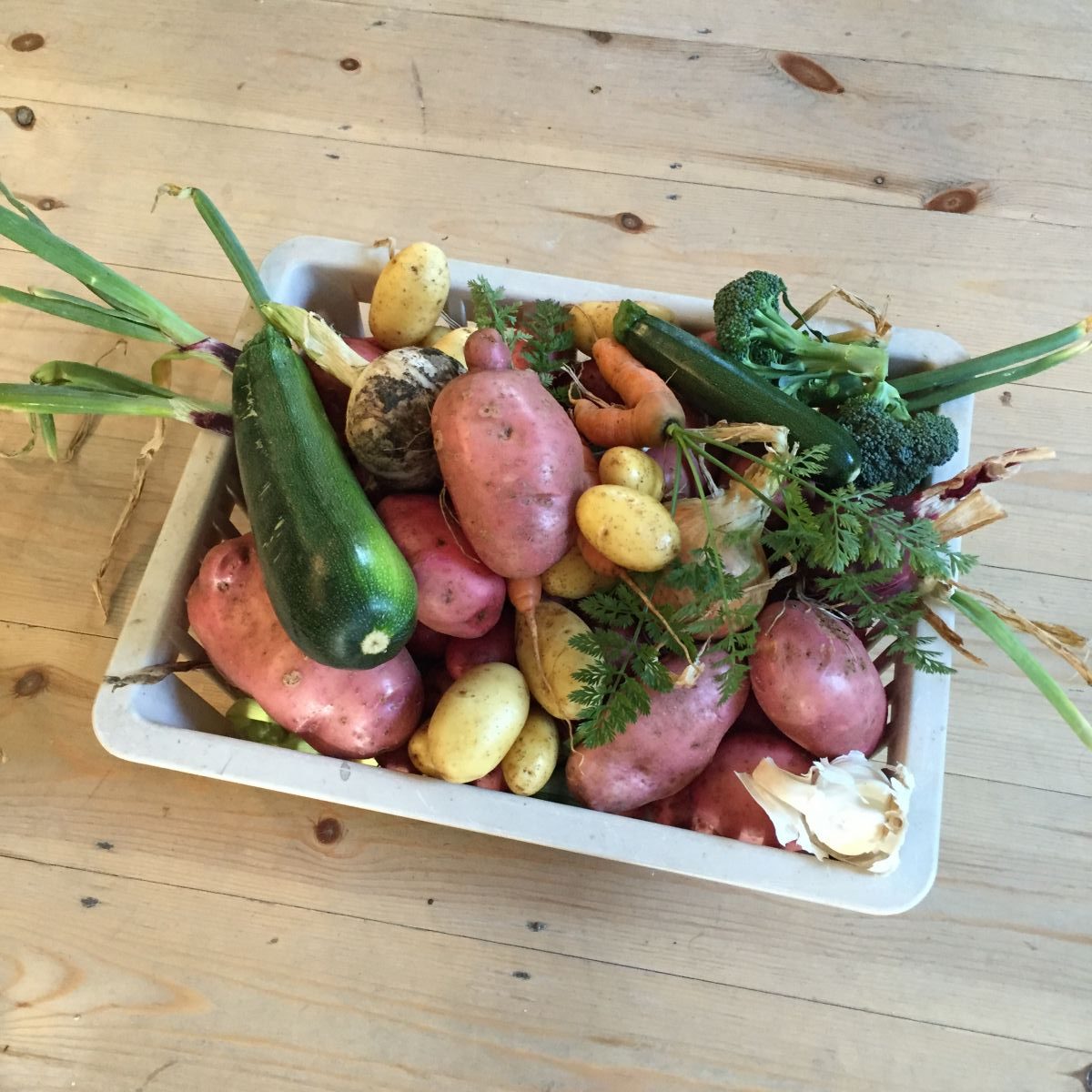
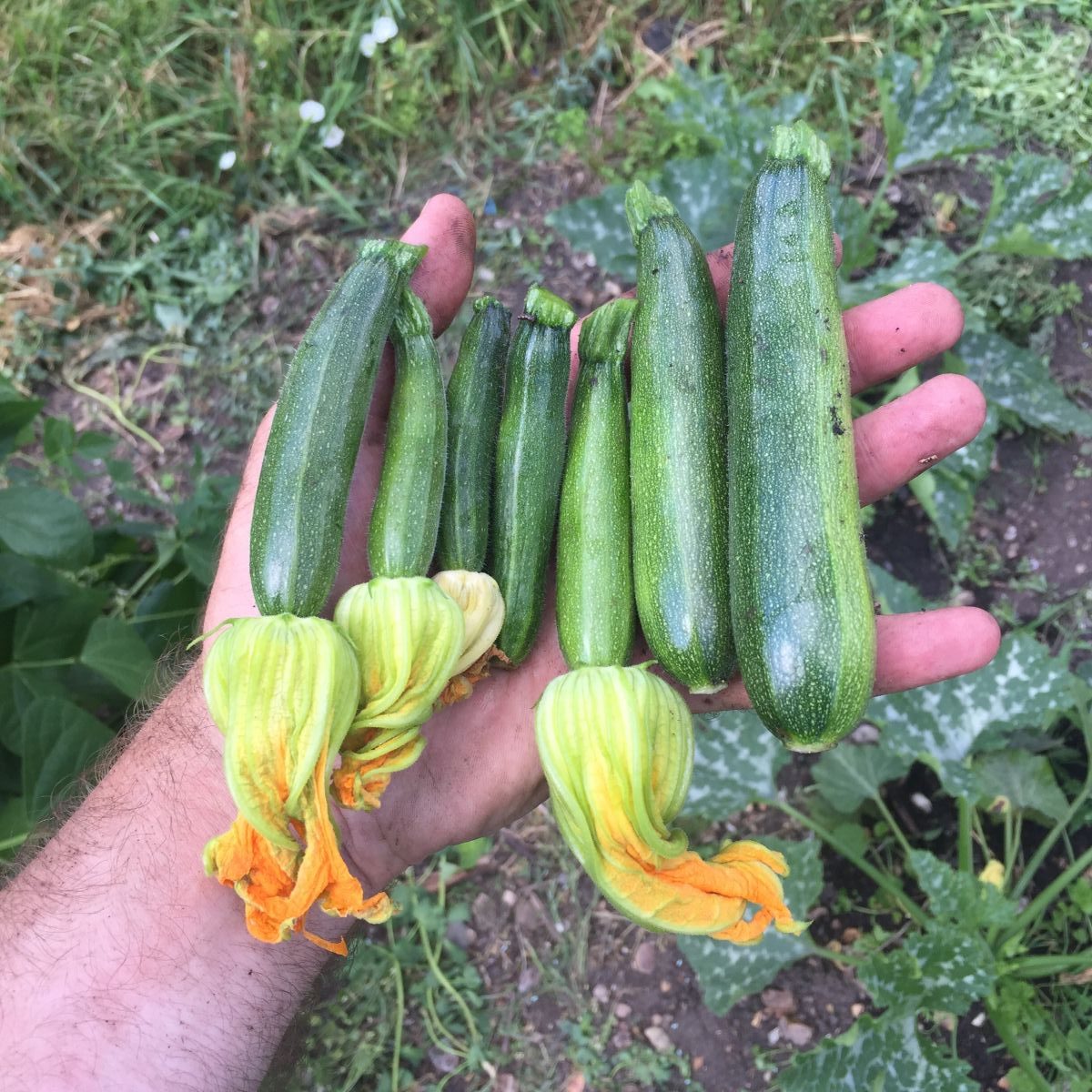
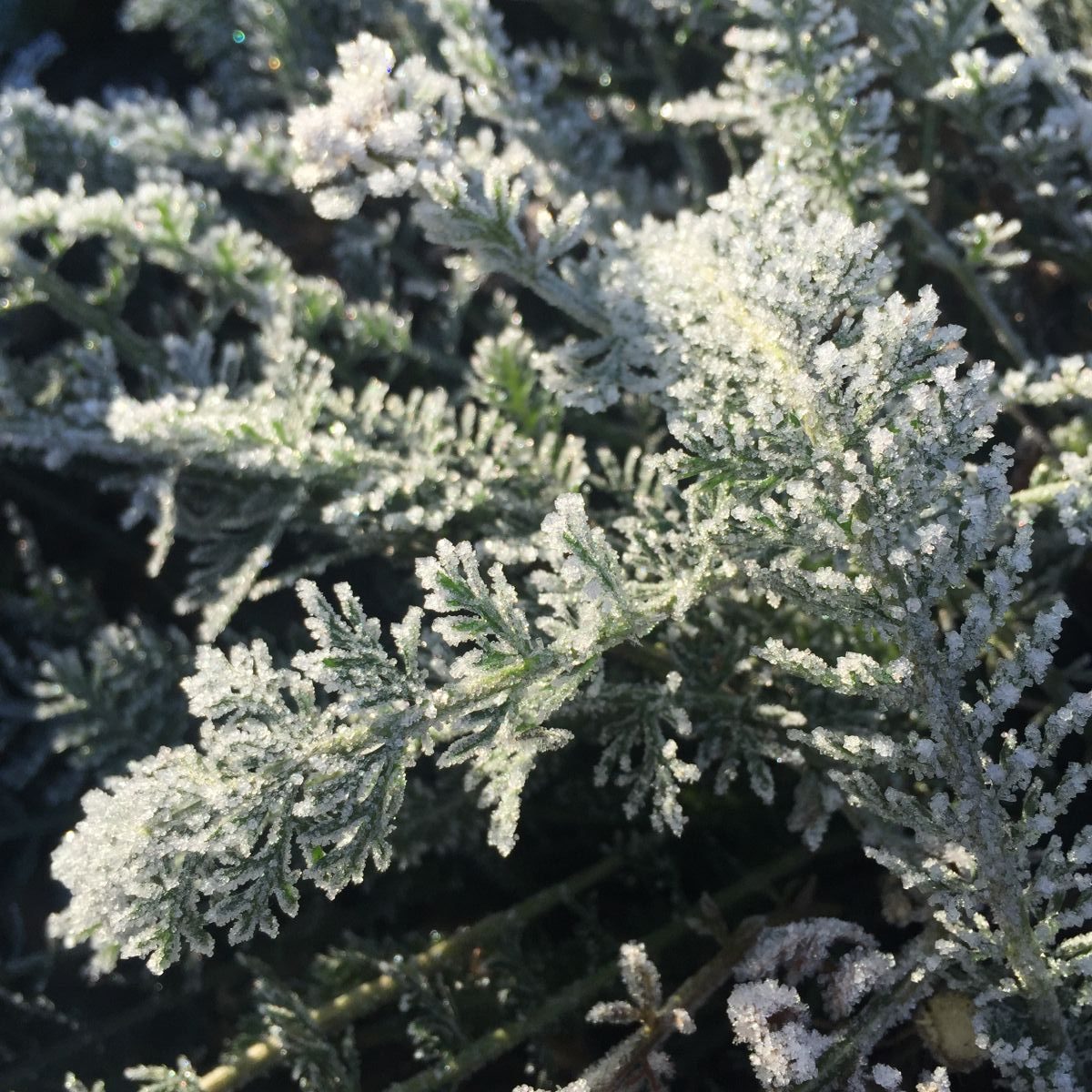
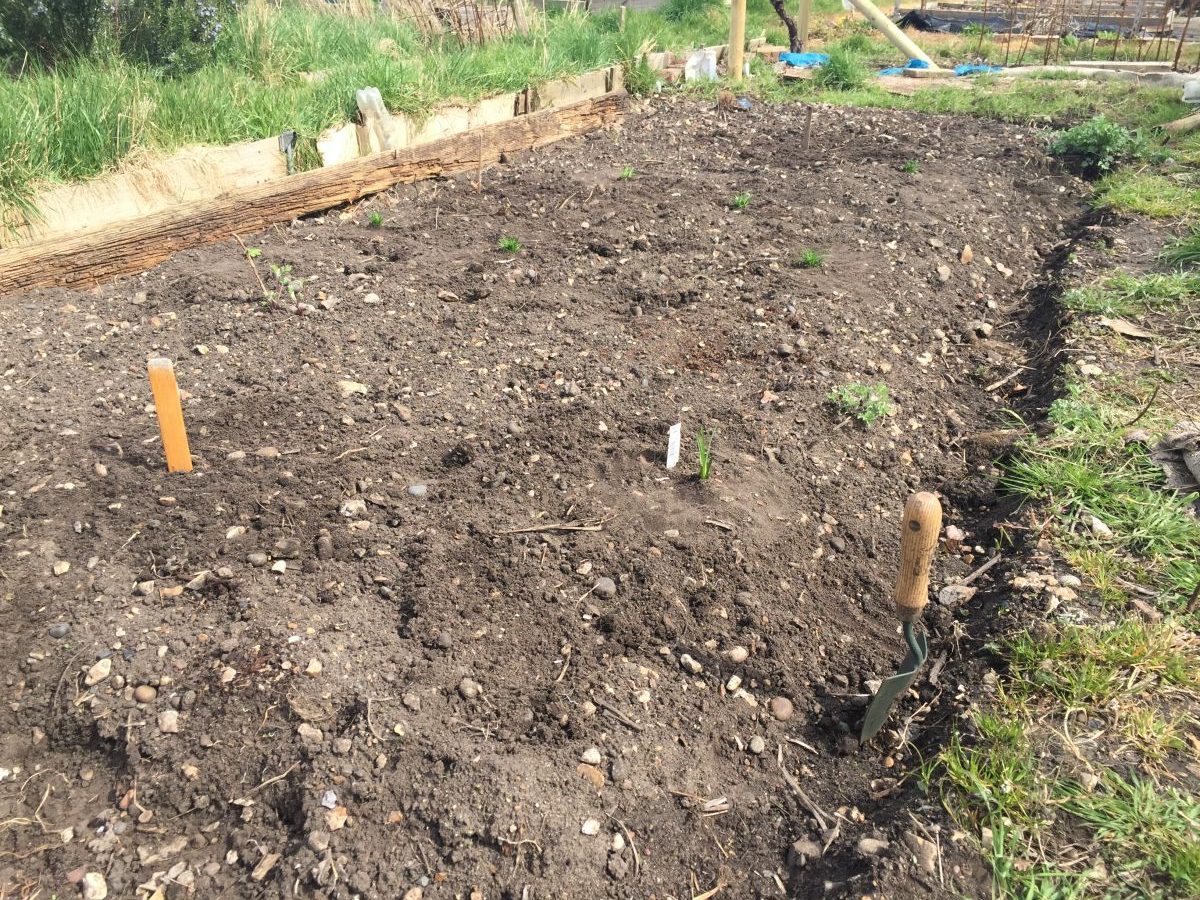
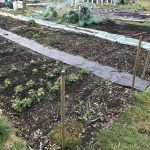
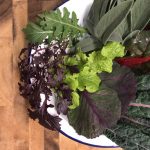
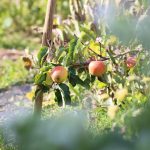
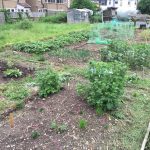
We went from one to three plots across 5-6 years, learning as we went, and this is probably the best list of practical tips for the real world I’ve ever seen for newbies! We always used to despair when we saw newbies come into the site and the first thing they would do was to start erecting “raised” beds (never actually raised, always just bits of wood enclosing sometimes completely random areas). We knew they would fall at the first hurdles. Those newbies who arrived, cleared their plot of rubbish, and started attending to the soil … They were the stayers. I created a rotation plan which went about 7 years ahead 😂 And was an avid user of spreadsheets. Have to do something to fill the long winter evenings!!
Well done, Jack!
Thanks Sharon, that’s really lovely of you to say! I’ve had some great feedback about this allotment post which caught me a bit by surprise, but it sounds like my experience matches very well with others like yourself 🙂 I think for newbie allotmenteers, going in can be scary because of the unknown. I want to tell people to not be scared of that, it’s their patch of land, they can do what they like 😀 I think you’re right about the raised bedders vs weeders. It’s usually a sign of people who understand soil. The exception of course if the ground is waterlogged, then everyone there should have raised beds! 😀
I do love a winter evening spreadsheet rotation plan as well 😀
Sharon, as a Spreadsheet guru – I have a tattoo of Excel! – and a new allotment owner, if you don’t mind sharing your SS, I’d love to see it.
OMG – I am a newbie about to erect a ” no dig” bed – I also think I feel pressured to start cultivating part of it because of the ethos of the allotment mafia – use it or lose it – which I do understand – can I start of small and work my way backwards ? I am mindful that it will be a work in progess and I am sure in a few years with the benefit of hindsight and knowledge I would do things differently but I do feel to learn I just need to start somewhere- really helpful tips – thanks 🙂
Hi Alison, yes absolutely. A no dig bed is just a patch of soil with a layer of compost on top, so it can be any size you want. You plant into the compost and top of the soil.
I’m a mega newbie so not very knowledgable on the topic, but have been looking into the no dig method, and it’s more than just compost on top, it’s about creating multiple layers of compost and straw (or another mulch), on top of newspaper, cardboard, and sometimes branches, which rot down and create heat in the winter.
Alison, I would try not to be put off about making raised beds by the notion that raised bedders aren’t stayers in the eyes of other allotment holders. You have to do what inspires you, and as far as I can see, raised beds can have lots of advantages too. Good luck!
PS this article is super useful and is really helping me with working out what I’m going to do on my plot 🙂 Thanks for all the info!
Sharon, I have just acquired my first allotment at age 62 as part of my ‘retirement plan’ to keep active, get outdoors, mix with others, pursue a hobby. I’ve never really done much gardening in the past (for various reasons), but was enthused by a visit to my local allotment site where, after a walk around, was shown a very nice half-plot, which I started clearing last Sunday.
One thing I would like to ask – you talk about the newbies and say:
“We always used to despair when we saw newbies come into the site and the first thing they would do was to start erecting “raised” beds (never actually raised, always just bits of wood enclosing sometimes completely random areas). We knew they would fall at the first hurdles”
My new patch already has 7 beds like you describe – timber framed by wood which is about 5 inches high. I assume that these don’t fall into the category you describe, and should be kept.
I have started clearing the area first, including strimming the long grass, clearing out the small shed, weeding the beds and turning the soil (which I will cover with weed barrier until I am ready to plant). Also putting time into planning where everything will go as I don’t want to start something to find that I need to re-arrange.
Hello I have just taken on my first allotment at 67 and love it . I. Still clearing rubbish and will like yourself divide areas with wood till i know what grows best where
Trish
What a lot of people tend to do is start with wood edging, however, this often rots after 5 years. All the people in my area start off with wood, then usually move to a stone edging or just a path between beds, my dad and the other allotmenters call wood the “newbie” mistake, which is where I think Jack is coming from where he says people with raised beds aren’t considered stayers. Plus it can often be expensive, but keep in mind that I am a youth and haven’t managed an allotment on my own.
Just my 2 cents,
Ben
A very high value 2 cents Ben, yes I completely agree. There is no need for it unless the soil requires it because of drainage. Raised beds for the sake of it cause more problems than they’re worth.
Jack
This is a very well thought out post, Jack. It can be overwhelming and exhausting when you first get an allotment but anyone reading this list and following your advice will be getting off to a good start. I particularly like the advice to get to know your weeds, something that all horts need to learn. Your system of three long beds is a good one – what’s the length and width of each bed?
Thanks Caro! There’s lots of good allotment beginner advice out there but it all still feels a bit much when it doesn’t need to. I feel people worry to much about other allotment holders too and allotment committees – it’s time for everyone to unite to change that. People are generally friendly and I’m sure with mutual respect everyone can just crack on. The beds are 16m long by 1.2(ish)m wide. I like the system a lot. They could perhaps do with a path halfway so I don’t have to walk aaaaaaall the way around, but usually I just end up stepping across carefully and I can use all the growing space 🙂
I must say though one reason that we took on one of our plots was for the fruit bushes and trees. We inherited red currant bushes and apples that we don’t know the varieties of but they have provided loads of lovely fruit for years. I think it’s worth giving inherited fruit a chance before discarding it.
Our allotment best friend is weed control fabric it’s saved us hours of work.
Hi Sue, yes, perhaps I was being too hasty about the plants. You’re right, it would certainly be less wasteful to see if they are still productive. In this first year I did keep the rhubarb, raspberries and a grape vine to see how they faired. The raspberries and rhubarb did do well. However all of the raspberries were summer fruiting, so we had a huge glut of them. Last month I removed half of them to replace with autumn fruiters. The grape vine performed extremely badly though I will try one more time. The rhubarb I am tempted to remove because I’d like to try named cultivars for future reference. I’m sure the plant is fine though.
Good tip with the weed control fabric – that’s a key pointer for newbies actually. After all the hard work weeding over winter it can be a huge blow to see how quickly they grow back in spring! 😀 That said, the hard work pays off and with your advice of weed control fabric, much easier to keep on top of.
Some great ideas and relevant to those taking on an overgrown private garden as well.
When space is tight, I go for things that are so much better freshly picked – broad beans, sweetcorn – and those that you can’t find easily in the shops (at least not in this part of the country) – cavolo nero, chard, gooseberries and blackcurrants. Soft fruit also takes very little work and can be frozen so a sudden glut isn’t as much of a problem.
Great post with some really sound advice! The only area I’d differ is in keeping hold of the rhubarb and raspberries – at least for a season to see if I liked them! I’d either have fun trying to ID them, or just enjoy eating them without knowing their identity. There’s always room for an anonymous lovely.
Hi everyone my husband and I have just taken on an allotment and LOVING it. We don’t know that much but have spent two weekends digging and weeding and planning! I have grown a few things at home in the past but not on a big scale but we just love the outdoors and the freedom of having an allotment. We are both 60 this year but full of enthusiasm and have resigned ourselves that mistakes will be made but so what? At the moment we find it so satisfying- good for the body and that well deserved glass of wine after a satisfying dig!
Sounds wonderful Nicky and your approach is exactly right (especially the wine!!) Mistakes will happen and that’s the fun. You’ll learn so much so quickly, by the end of summer you won’t even care. There are lots of crops you can just keep on sowing, like carrots. So there’s no problem in mistakes as you try again. Also something to be said in just going for it and planting lots and lots. Hard to look after but some will stick and then you’ll be able to enjoy the ones that do well and care less about those that don’t. Good luck! Please do keep us all updated on your progress 🙂
Oh my goodness this is exactly what I need!
After nearly 2 years of waiting I got the phone call this week saying there’s an allotment available for me. I’m going to view it tomorrow morning. I have absolutely no idea what I’m doing so your advice is perfect, thank you!!
Really excited but also nervous, don’t want fellow allotmenteers to look on in pity as I flounder about.
Do not worry Clare! Forget about the others and flounder on, you’ll soon gain your confidence and be growing crops as good as the pros – even if by accident at first! (Like I do!)
So excited I’ve taken on two plots next to each other and have sooo much rubbish on to clear from one of them, its cost me a small fortune to get a gardner/clearance man To help me clear all the rubbish away. the previous owner was a builder and decided to use his plot for storage of random things I found a shower screen under a lot of weeds. I’ve got a very uneven surface that is covered in bind weeds and horsetail, in not sure what my next move is , to weedkill everything then once dead rotavate it to level it out? Any advice would be brilliant.
Hi Celine, yes I would take that step, with bindweed and horsetail it’s the only way to truly tackle it. That said, prepare for a battle on an allotment site. Definitely do that to start with but prepare to live with those weeds, so finding ways to keep them down over the years. I have bindweed and it’s very difficult to reduce. I just hoe and remove to try and keep under control a bit.
Hi, I’ve been Allotmenting for almost 30 years and was the first woman on my site at that time. My advice for newbies would be to focus on a few crops the first year and as your confidence and curiosity grows, increase your range. Also, don’t overdo it when clearing an unloved plot; little and often will ensure you don’t burn out.
That’s great advice Saronne! Thanks for sharing that for everyone 🙂
I took on a plot about 4 weeks ago. It wasn’t the worst of the ones I was shown (which included some veritable jungles), although it was very neglected, untidy and overgrown. It already has 7 low raised beds in situ and weed barrier paths in between.
However, it had been left a long time and it was very unkempt and overgrown. Contrary to what you suggest, I have gone a bit bananas regards clearing the site and spent a large number of days ripping out weeds, clearing undergrowth (or more specifically – overgrowth!) to the point that I haven’t yet stopped to enjoy it.
However, this week, I have planted 3 large beds (2 veggies and 1 flowers) as well as a smaller bed with mint and lavender. So I have finally slowed down a bit and actually sat on my bench to just reflect and ponder.
In hindsight, I think that I agree with you not to go bananas at first -particularly if you have limited time. Luckily my time is not limited and I am very impatient in wanting things to be done ASAP.
I do feel that I can now slow down a bit, sit down more and take in the whole peaceful ambience of the place.
I’m now on my 2nd season……..made loads of mistakes last year, which I’ll hopefully learn from. It’s great fun, and my fellow allotmenteers are really friendly and helpful.
You can’t beat being out in the fresh air, and knowing that you will be eating what you have worked hard for.
Some great tips which I will use going forwards – thanks
Absolutely! There’s nothing like being out there, everything else seems so far away 🙂
I’m now on my 2nd season……..made loads of mistakes last year, which I’ll hopefully learn from. It’s great fun, and my fellow allotmenteers are really friendly and helpful.
You can’t beat being out in the fresh air, and knowing that you will be eating what you have worked hard for.
Some great tips which I will use going forwards – thanks
Hi, I am thoroughly enjoying reading all your encouraging posts. I have taken on my first ever allotment, and having covered up all the undergrowth for the past four months I am now uncovering and digging over small areas for planting. It seems good soil although quite heavy- any suggestions for a first crop to try? I am keen on having both fruit and veg eventually but need a satisfying boost to keep me going! How much preparation does the soil need, and can I plant straight away?
Hello all,
I’ve just spent my first couple of hours on my newly acquired plot in Manchester. It’s been quite an eyeopener just to see how weeds can take over an entire area. I’ve taken on board Saronne’s advice and will do little and hopefully often so as not to feel overwhelmed.
Thank you Jack for your tips which make really interesting reading. I have no idea what I want to grow right now, I just want to clear the site. Tomorrow, fingers crossed, I will be more prepared for the tasks.
Good luck Caron! Clearing it can be a rewarding activity in itself and there is no rush to start growing anything. Looking back now, I’d make more of an effort personally to set up a proper compost heap from day one. Home made compost is so valuable and hard to create without at least two 1m wide compost bays. Have fun! 🙂
Jack
I have just dug up all of my new potatoes. Can l plant more potatoes in the same plot to harvest at christmas
Hi Michael, are you in the UK? It’s too late to sow potatoes now, they must go in in spring and then stored until Christmas. You can however sow turnips, beetroot and carrots this weekend for Christmas 🙂
I had to dig mine too, they finished growing due to the really dry weather. Planted a bag I got for 10p in the same place and harvested a reasonable crop in mid September.
Hello, pre-newbie here, just researching before I sign up to be a life-long ‘lottie’. Could you explain the netting, cane and coke bottle set up? Is that water in the bottles? Great article as well, very helpful in allaying some fears I have.
Hi Nicolette! Very simple system of empty bottles, they’re purely to help the net rest on canes. You could use upturned flower pots of others 🙂 you should give it a try definitely. It’s hard work at times but I’ve never looked back!
Jack
Thanks Jack! There’s me thinking it was some clever irrigation system. I’ll definitely give it some more thought.
Hi All 😊 have just got our first allotment, I am so excited. Thank you souch for taking the time to write down your experiences. The planning has been really helpful and has really encourage me that I will be able to do this. Also completely right the satisfaction of getting those weeds out by hand was awesome… My 2 little girls even enjoy the time we spend there and my 7 year old has ambition to grow a pineapple!!!! as we have been given a potting shed …… Thank you for sharing. 😁😁
No probs, have fun Adina!
Another allotment newbie here, I have just read through all your allotment posts and found them very inspiring. The only gardening I have ever done is in my own garden at home which is very small so having so much space is quite intimidating. I look forward to your future installments
Good luck Cristin you will love it! It’s hard work for sure but you can have success alongside weeds and imperfection as my allotment shows!
Thank you for such great advice for newbies. I took on a half plot in April which had not been cultivated for three years. Inspired by you I cleared the site and got rid of all the rubbish and plants except a cherry tree that the other allotment holders said had the most amazing fruit.
I have hand dug over the whole plot four times as the dock and dandelion roots were so deep.
I have designed and redesigned umpteen times my layout, which incidentally does have raised beds as I felt it would be easier for me to manage. All my beds are now full of either young plants I was able to buy ( as I’m so late in the season) or seeds.
I am learning on the job, the other allotment holders are so friendly and supportive, already I have picked up so many tips from them and look forward to many years of a healthy hobby and fantastic organic fruit and veg.
Sally, this all sounds wonderful! You’ve hit the ground running and have crops on go, what a perfect way to start summer. I can’t wait to hear how your allotment adventures progress in the years to come.
And a free established cherry tree, what a bonus!
Jack
Hi I’m an absolute novice and have just been given an allotment to work. I have a couple of raised beds that I am keeping for my grandchildren to plant up. We have weeded, dig over and added some compost and top soil to try to enrich the beds. The kids plants some herb plants, carrots, onions and a few cabbages. They also squeezed in a couple of tomato plants. I know that this is a lot but we bought the plants and only had one bed ready for them. I plan to thin out the potential ‘crop’and transplant these into the second one. The rest of the plot is rough grass, the soil looks and feels heavy ( clay) so I’m not sure what would be the best course of action. Any advice would be very much appreciated. I think that I’d like to cultivate a section at a time but what should I do with the remainder?
Thanks
Chris
What brilliant advice for a total newbie like me – who picked up the keys to my plot today! Thank you for sharing your knowledge, ill be sure to devour all information I can find. I’m determined to make it work. Feeling a little overwhelmed as not sure where to begin, but I guess having a thorough clear out is a great starting point.
Thank you 😀
Thanks Byron, have fun and good luck. The feeling of being overwhelmed is normal and it goes with time. Although it pop backs with the weeds after a holiday! Haha
Jack
Hi,
Like most people on your great site, I have just taken on a very overgrown allotment. While clearing it I’m also planning layout etc.
I am wondering why all allotments are always laid out in such a straight and rather boring design. Are there any examples of more interesting and creative layouts ?
I just wondered.
Hi Julia,
Interesting question, I imagine it’s purely out of practical reasons. E.g. it’s easier to divide up a site in this way, plots tend to run from east to west though not always (for light) and also that most veg is grown in rows, so rectangles or squares make sense. That said, I know of oval and round kitchen gardens, so you never know, there may be some more interesting ones out there!
Jack
Thanks Jack,
I wonder if anyone has done layout plans that are a bit more creative? I want to use my allotment as a garden, not just for growing vegetables, but also flowers, and ideally also just to sit there and relax.
Do you know if any garden designers who have ‘designed’ an allotment perhaps?
I don’t want to sound arrogant towards all of you very experienced gardeners, but I am just so excited about my little patch and want it to be a really happy place to be.
Julia
Hi Julia, I don’t know of others but I’ve designed a few allotments and kitchen gardens. When I do I always start with how it’s used first, as I do with gardens, as it has to be usable above anything else. Then work up from there. Have fun with yours, as long as you don’t put permanent things down like paving you can experiment and move areas around. I have a few flower beds (in my other allotment blog posts) and an orchard etc.
Jack
Great advice!
I’m just about to take on a half plot. I noticed you said you didn’t have a car, I don’t drive and I’m a bit concerned about clearing the plot and getting manure on site etc. How did you find it?
Clearing a major problem if metal, glass or plastic. I have a four year old pile still. But it’s tucked behind a shed. Compost etc easy with delivery, usually from local suppliers.
Thank you for all these tips. I have just taken on my first ever allotment plot today after my first year of veg & fruit growing last year (in tubs on the roof of my flat). So I am super novice and am quite scared of making a huge disaster of my plot :/ But my aim is to create a mini permaculture haven to include an edible garden and ‘wild’ patch for pollinators to thrive.
I will surely use some of the tips in here (although I hate the thought of skipping anything already on plots unless 100% necessary. Trying to reuse materials for other purposes is much better than landfill.
😀
I am a newbie at 67. I would like to grow some plants to aid the bees/butterflies etc.
The plot is covered in grass/weeds so plan to cover 2/3 with appropriate fabric itil weeds have died and try to work on remainder, getting the soil fit for purpose. Am I on the right track please? All donations greatly appreciated.
Thank you. Joy.
Hi Joy, yes you are definitely on the right track. The matting will keep things under control allowing you to work on smaller bits at a time. It would be worth leaving some of the weeds because they are the plants the bees and butterflies want the most. For instance, nettles are essential for peacock butterfly caterpillars.
Jack
I have loved reading your post Jack and all the helpful comments too. We have just picked up the keys to our first allotment and have sat down and read through your blog and other advice. The plot has been covered already, which is great, but I think today’s job will be to start removing all the stones (incentive put in place for the kids to help) . We’ve put our initial thoughts of raised beds to one side and will focus on the soil and not using them at all. Thank you for your brilliant advice.
Thanks Sarah and have fun on your new plot! My plot is full of little stones that I don’t worry about. It’s good to clear for root veg like carrots to stop them going wonky but everything else just grows around them.
Jack
Hi Jack,I have just got my allotment this morning and am looking forward to getting stuck in to clearing and weeding the plot. Is it better to have one big area to tend or to leave existing strips of grass to walk along?Thanks
I would personally get rid of grass unless you’re sure there is no couch grass in it. Grass is the most annoying ‘weed’ of veg beds long term.
Have fun!
Jack
I have just acquired an allotment. As its end April, and wanting to make use of this season I have planted as much as I can with what I can obtain in these days of coronavirus restrictions – so potatoes, onions and various veg seed. Have I done the right thing or should I have taken my time and imported some manure to improve the soil, but maybe miss the boat on some of the produce? With manure, is it better to buy bags from garden centres or ship a load in from a farm, risking bringing weeds and nettles with it? Thanks. Very useful tips on here!
I think you’ve done the right thing because you can do both! Add compost around plants to improve the soil and fertilise. You
Could use chicken manure pellets. And there’s still loads of time to plant more, so add more compost / manure to other areas and plant a few more things. See if there is a difference 🙂
Have fun
Jack
Hi 🙂
Really enjoyed reading your blog after recently acquiring my first half plot. Although feeling overwhelmed with where to start with all the different advice out there. I’m not sure what a standard allotment size is but I measured mine at 20m x 10m and it feels massive! Plus some uneven ground so am hoping that it won’t be too difficult to level it out a bit.
Have come to accept that I am going to have to split it in half (if not smaller!) and possibly not grow any produce for the next few months if I prepare the ground properly. I plan to trim the grass and weed one half before creating some beds. But covering the other half in the meantime with an opaque, permeable ground sheet. Does this sound like a good idea? I like the idea of the no dig method and layering various compostable materials but not sure I could do this given the size of the plot.
Any advice would be greatly appreciated! Thank you 🙂
Hi Jack,
any tips for layout of a long and narrow plot?
I have one side of a 8mx25m plot that runs north / south. We have a shared path that goes between our sides.
Hi, I’ve just been given the other 1/4of my plot, so now the proud owner of a half plot. 18 x 65 feet.
I’m getting it rotavated on Saturday. Do you think it would be ok to add some fresh horse manure to the ground before I cover with weed membrane. Only until I design how I’m hoping to use it later on? Thanks
In my experience, you are better keeping the pile of muck for a few months to allow it to truly rot down. Spreading it out on your ground even covered is asking for trouble eg nettles, weeds – anything the animal may have eaten.
Hello Jack, I took on my allotment (20 x 12m) in January after reading your blog and taking the plunge… thanks for giving me the confidence to go for it. I’m in the Netherlands- a bit east of the middle- so it’s not the maritime climate that I was used to in Suffolk. There was no waiting list and it had been left clean of weeds and was prepared for the new season with manure by the outgoing tenant, which was fantastic. I went for treading my paths, compacting the soil, and that’s working well to inhibit the growth of weeds on paths. One thing that isn’t mentioned here is green manures… the first thing I did was sow phaecelia -tansy? – in March on the half of the plot that I didn’t immediately need and that worked really well. I have other green manure seeds waiting in the shed for when each bed is cleared, from memory yellow lupin and red clover though I think I must be careful to chop down and compost before the clover sets seed as it can be a nuisance. But the phaecelia was brilliant for keeping other weeds out and easy to incorporate into the soil. I inherited a raspberry which turned out to be a yellow autumn one… rhubarb and the rest was a blank canvas. Fruit trees, berry bushes and artichokes help to fill up the space. We have eaten almost nothing but our own veg now since the beginning of June (a bit ahead of UK?) …it’s wonderful. Good luck everyone… enjoyed reading this again! Janet ps let me know if you are in NL….
Nothing gives a better return than runner beans. Grown vertically they have an attractive vine, beautiful flowers and a huge amount of food that costs 5 pounds 68 pence a kilo in Tesco and tastes so much better. The first and pretty much only rule is, you don’t need as many plants as that, no really you don’t , twelve plants will fill your freezer, plant them twice as far apart as you thought and build a supporting frame twice as strong as you thought to avoid collapsing in the wind under the weight of your crop. Bamboo canes are not strong enough unless they’re an inch thick and they need to be 3 m . Keep picking.
After a two year wait we got our new allotment in the first lockdown, it has been a great benefit towards saving our sanity.
Really enjoyed reading everyones tips and advice,just got out medium size first ever allotment this week,triangular shaped plot its been left in excellent condition for us and can’t wait to get digging and preparing to grow.
We got our allotment last March 2021, thought we would have just a half, it was so over grown but got down and dug it over, then we decided to have the other half, so I’ve put some flowers in the top as feel it’s good for pollinating also looks interesting and more room for extra veg,
The people on the allotment are very friendly and kind, gave us lots to get us going,
We had lots of courgettes & runner beans, potatoes radishes sprouts had lots of comments how well we had done, the soil I think is good, we now putting a lot of fertiliser down, and put more wood beds down, and invested in a polly tunnel,
A good tip I thought about the canes and netting, It has give me a lot of pleasure,also good for your well-being, As made redundant which I didn’t mind as I was due to retire
Thanks for this article Jack. I was gifted a lot this week by my son. He knew I wanted one, and so the journey begins. I have still to find out where, how big and possible rules of the site. I am in Canada, so probably a little different than back home. We will be going to look at the plot this weekend.
I am on a very limited budget, so knowing I will need only a few tools is helpful. I am wondering if I need to condition the soil, or put down a layer of compost. I have never gardened before, as I have always lived in apartments.
I have started some seed on the window sill today, lettuce, cherry tomatoes, yellow squash (zucchini,) radishes and broccoli. I want to add potatoes and carrots to these but will sow those directly into the garden.
Thanks again for the help.